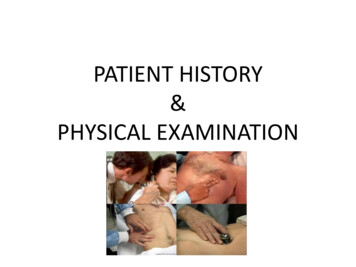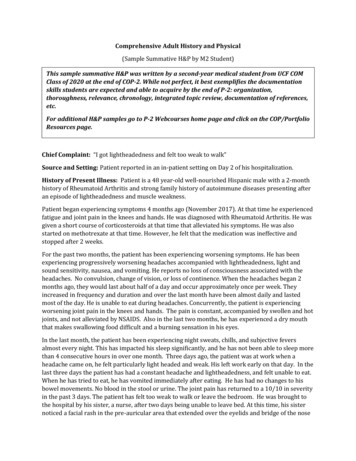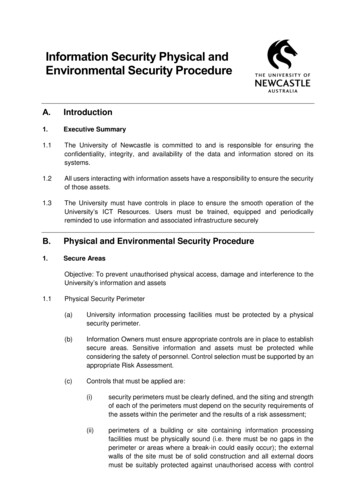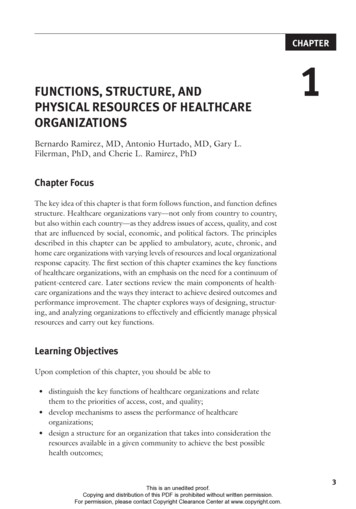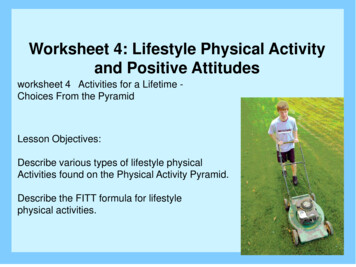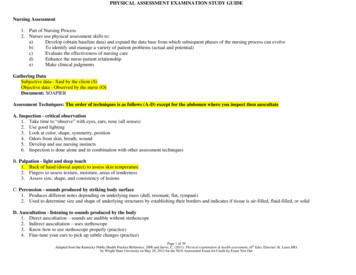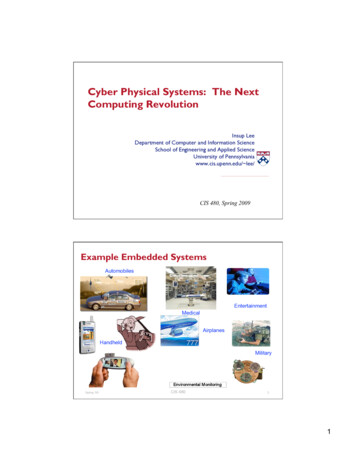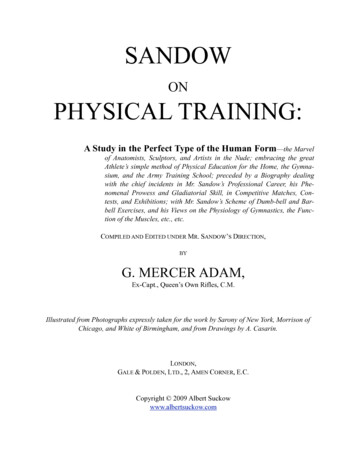
Transcription
SANDOWONPHYSICAL TRAINING:A Study in the Perfect Type of the Human Form—the Marvelof Anatomists, Sculptors, and Artists in the Nude; embracing the greatAthlete’s simple method of Physical Education for the Home, the Gymnasium, and the Army Training School; preceded by a Biography dealingwith the chief incidents in Mr. Sandow’s Professional Career, his Phenomenal Prowess and Gladiatorial Skill, in Competitive Matches, Contests, and Exhibitions; with Mr. Sandow’s Scheme of Dumb-bell and Barbell Exercises, and his Views on the Physiology of Gymnastics, the Function of the Muscles, etc., etc.COMPILED AND EDITED UNDER MR. SANDOW’S DIRECTION,BYG. MERCER ADAM,Ex-Capt., Queen’s Own Rifles, C.M.Illustrated from Photographs expressly taken for the work by Sarony of New York, Morrison ofChicago, and White of Birmingham, and from Drawings by A. Casarin.LONDON,GALE & POLDEN, LTD., 2, AMEN CORNER, E.C.Copyright 2009 Albert Suckowwww.albertsuckow.com
TOLIEUT.-COLONEL G. M. FOX,HER MAJESTY’S INSPECTOR OF GYMNASIAFOR THE BRITISH ARMY, ALDERSHOT,I DEDICATE THIS WORKIN GRATEFUL REMEMBRANCE OF MANY ACTS OF FRIENDLYCOURTESY, AND AS A TRIBUTE OF ADMIRATION FOR AGALLANT SOLDIER AND A ZEALOUS ADVOCATEOF PHYSICAL TRAINING ALIKE FOR THEMILITARY MAN AND THE CIVILIANEUGENE SANDOWNEW YORK, January, 1894
Sandow’s System of Physical TrainingPage iPREFACETHE following pages have been prepared under Mr. Sandow's direction and personal supervision. In the practical section appended to the narrative account of the great athlete’s early amateur and later professional life, Mr. Sandow has furnished detailed instructions for the performance of his dumb-bell and bar-bell exercises and supplied the reader with a text-book which, hewould fain hope, will be useful to the would-be athlete and to all who desire to attain perfecthealth, increased strength, and the full development of their physical frame.Since the volume was put in type, further testimony, of a gratifying kind, to the value of Mr.Sandow’s system of physical training has come to hand, in Captain Greatorex’s courteous letter,to be found in the Appendix. It is regretted that the communication was not received in time toinsert in the chapter to which it belongs—that on “Physical Culture in Relation to the Army.” Theletter forms a pleasant pendant, much prized by Mr. Sandow, to the one which appears in thechapter referred to, from Colonel Fox, H. M. Inspector of Military Gymnasia for the Britisharmy.The illustrations to the practical, as well as to the narrative portions of the book will, it is believed, add no little to its value. To the courtesy of Messrs. Sarony of New York, Morrison ofChicago, and H. Roland White of Birmingham, England, the publishers are indebted for permission to reproduce the photographs.The Editor takes advantage of this prefatory note to acknowledge his obligations to Mr. Sandow and his pupil, Mr. Martinus Sieveking; to Mr. W. T. Lawson, member of the New York Athletic Club; to Dr. D. A. Sargent of the Hemenway Gymnasium, Harvard University; to Dr. Everett M. Culver of New York; to Dr. W. Theophilus Stuart of Toronto, Canada, and to the Publishers, for courtesies received during the preparation of the work.NEW YORK, FEBRUARY 1, 1894.www.albertsuckow.com
Sandow’s System of Physical TrainingPage iiCONTENTSI. A Plea for Physical Education. . 1II. Sandow, A Titan in Muscle and Thews. 7III. Sandow’s Boyhood and Early Life. 12IV. Sandow as a Strongman in Holland. 16V. Sandow as a Wrestler in Italy. 22VI. Sandow Wins His First Laurels in London. 26VII. Defeats Samson at the Westminster Aquarium. 32VIII. Sandow in Scotland and at the Centers of Industrial England. 38IX. With Goliath at the Royal Music Hall, Holborn. 42X. Another Strongman Contest. 45XI. Sandow Breaks All Records. 49XII. Physical Culture in its Relation to the Army.55XIII. Sandow “At Home” and Abroad. 61XIV. Sandow in the New World. 65XV. Sandow as a Physiological Study. 76XVI. Sandow Speaks for Himself. 82XVII. The Physiology of Gymnastics. 89XVIII. Hygienic and Medical Gymnastics. 96XIX. Exercise and the Bodily Functions. 108XX. The Chief Muscles, Where They Are Situated, and What They Do. 115Figure, Skeleton, and Muscles of the Athlete.126Exercises . 128www.albertsuckow.com
Sandow’s System of Physical TrainingPage iiiLight-Weight Exercises. 133Heavy Weight Exercises. 145Bar-Bell Exercises . 156Sandow’s Physical Training Leg Machine.164Appendix A. 169Directions for Reading the Sandow Anthropometric Chart.170APPENDIX C. Table of the Increase in the Measurements. 172APPENDIX D. 174www.albertsuckow.com
Sandow’s System of Physical TrainingPage 1SANDOW ON PHYSICAL TRAININGI.A PLEA FOR PHYSICAL EDUCATION.IN spite of the increasing value of individual life—the distinctive mark of the civilization ofour time—little has yet to be done, on large lines at least, to secure for the masses of the peoplewho do the work of the world that degree and maintenance of physical well-being implied in thephrase, “a sound mind in a sound body.” For those even whom we are pleased to call “the flowerof our population,” we have systematically and intelligently done next to nothing in the way ofphysical culture. Only in recent years has physiology been put on the curriculum of our publicschools and the young have been enabled to get some inkling into the frame-work of their bodiesand the physical conditions on which organic life is held. Whether this knowledge, in the main,goes beyond an appreciation of the necessity for air, light, food, clothing, and cleanliness, asconditions essential to health, may be greatly doubted. What is remembered of the theoretic lawsof health when school-days are over, is, if we except the case of the comparatively small contingent that goes on to the study of medicine as a profession, of little value in the practical government of our bodies. Even what we have picked up about sanitation is generally lost before wehave well entered upon manhood, or is effectively and grimly set at naught in our homes by theplumber. Where physiology has been properly taught, we may not all be as heathen in ourknowledge of the requisites of health. In a few fortunate instances, the youth may know something of the process of waste and renovation in the body; but how those processes work to thebest advantage and show their most beneficent results the systematic exercise of the muscularwww.albertsuckow.com
Sandow’s System of Physical TrainingPage 2system, is, admittedly, given to but few of us to appreciate or wisely to understand. Even the ancient Greeks, noted as they were for their fine physical development, grace and symmetry ofform, groped largely in the dark regarding many things which modern physiological science hasnow made plain. This is well understood; but, with the higher knowledge that modern sciencehas brought us, how indifferent has been our approach toTHE CONSUMMATE BEAUTY OF PHYSICAL FORMfor which the Greek—especially the Athenian athlete—was famed. Greek and Roman alikeknew, in a high degree, the value of bodily exercise, and in their competitive games, as well as intheir training for war, adopted a system of physical education which produced wonderful results.They knew nothing, however, of biology and the marvel of the body’s cell-structure, the keywhich, it may be said, has opened to a modern age the doors of its microscopic vision and revealed almost the secret of life itself, with its ever-recurrent motions of waste and renewal. Theydid not know, and Mr. Archibald Maclaren, the great English authority on Physical Education,has observed, “that man’s material frame is composed of innumerable atoms, and that each separate and individual atom has its birth, life, and death; and that the strength of the body as awhole, and of each part individually, is in relation to the youth or newness of its atoms. Nor didthey know that this strength is consequently attained by, and is retained in relation to, the frequency with which these atoms are changed, by shortening their life, by hastening their removaland replacement by others; and that whenever this is done by natural activity, or by suitable employment, there is ever an advance in size and power, until the ultimate attainable point of development is reached. They simply observed that the increased bulk, strength, and energy of the organ or limb is in relation to the amount of its employment, and they gave it employment accordingly.”Thus, in the main, was the sum of knowledge possessed by the ancients in relation to physical training; yet unscientific—as we now understand the term—as it was, its results were wonderful in promoting strength and activity. Of course, in giving themselves so ardently to physicaleducation, the Greeks and Romans must have observed much else, as the results of muscular exercise, that was beneficial to the youth in training. Though they had little knowledge of the whyand wherefore in physiological law, they saw its gratifying effects and so betook themselves,with increasing national enthusiasm, to the exercises of the gymnasium and the campus. Thephysiological action on the lungs and the blood produced by quickened respiration, incident toregular periods of muscular exercise, they might not know; but they saw clearly its health-givingresults, on the mind as well as on the body, though no doubt, with them as with us, it was the fewonly who were qualifying themselves for the service of war who had the benefit of this experience in training. Interest in the physical well-being of any beyond those who were designed tobear arms, there was none in either Athens or Rome. Outside of that favored class there was nopublic provision for physical education; though there were always patriotic and high-spiritedyouth whom the thirst for distinction drew into the competitive arena to take part in wrestlingcontests, swimming matches, chariot racing, and other national sports and games. With us, ofrecent years at least, physical training has gone beyond the parade-ground or barrack-room of thesoldier. It has happily found its way into our schools and colleges, and, in a few of them, at anywww.albertsuckow.com
Sandow’s System of Physical TrainingPage 3rate, it takes a place on the curriculum hardly inferior to that assigned to intellectual studies. Oflate years, also, provision has specially been made for it by athletic clubs and other organizationsfor recreation, of a private or corporate character, with results that have gone far to neutralize thephysical deterioration that in our over-competitive age is incident toTHE JAR AND FRET OF BUSINESS LIFE.Theoretically, at least, we all pay tribute to the value and importance of physical education.We admire physical strength and beauty, and recognize, though only faintly as yet, the interrelation of mind and matter. We know, moreover, that a healthy, active brain is sadly handicappedby an ill-developed, sickly body. We see around us every day of our lives masses of our race ofimperfect growth and unsound constitution, and almost daily the lesson comes home to us of thebreak-down of some friend or acquaintance, whose weakness of body could not withstand themental and bodily strain in the struggle of life. Yet it is not strength, so much as health, that is thecrying want of the time. It is stamina, and the power, in each of us, to do our daily work with theleast friction and the greatest amount of comfort and ease. Only the few are called upon, like thegreat traveler or the soldier
their training for war, adopted a system of physical education which produced wonderful results. They knew nothing, however, of biology and the marvel of the body’s cell-structure, the key which, it may be said, has opened to a modern age the doors of its microscopic vision and re-vealed almost the secret of life itself, with its ever-recurrent motions of waste and renewal. They did not know .
